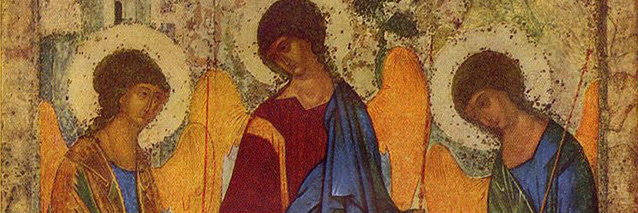




"Matter and Spirit must be found to be inseparable in Christ before we have the courage and insight to acknowledge and honor the same in ourselves and in the entire universe."
Richard Rohr's Daily Meditation

"Trinity" (detail), c. 1410, Andrei Rublev. Tretyakov Gallery, Moscow.
"Fathers of the Eastern Church"
"Christ is Everyman and Everywoman"
Monday, 11 May 2015
Many passages in the New Testament give a cosmic meaning to Jesus as the Eternal Christ (Colossians 1, Ephesians 1, John 1), but the Eastern fathers of the Church were the first (and last) to make this into a full theology until Bonaventure and Duns Scotus in the 13th century and Teilhard de Chardin in the 20th century. This theology of Christ was never developed in the West, which is why it seems like a new idea to most Catholics and Protestants.
Many of the Alexandrian school saw Jesus as a dynamic and living ("interactive") union of human and divine in one person. They saw Christ as the living icon of the eternal union of matter and Spirit in all of creation. Jesus was fully human, just as he was fully divine at the same time, but dualistic thinkers find that impossible to process, so they usually just choose one side or the other (Jesus is divine and we are human, missing the major point of putting them together!). Matter and Spirit must be found to be inseparable in Christ before we have the courage and insight to acknowledge and honor the same in ourselves and in the entire universe. Jesus is the Archetype of Everything.
One of my favorite Orthodox scholars, Olivier Clement, helps explain the Eastern fathers' understanding of Christ with some profound statements of his own:
- "How could humanity on earth, enslaved by death, recover its wholeness? It was necessary to give to dead flesh the ability to share in the life-giving power of God. He, though he is Life by nature, took a body subject to decay in order to destroy in it the power of death and transform it into life. As iron when it is brought in contact with fire immediately begins to share its colour, so the flesh when it has received the life-giving Word into itself is set free from corruption. Thus he put on our flesh to set it free from death."[1]
- "The whole of humanity, 'forms, so to speak, a single living being.' In Christ we form a single body, we are all 'members of one another.' For the one flesh of humanity and of the earth 'brought into contact' in Christ 'with the fire' of his divinity, is henceforward secretly and sacramentally deified."[2]
Perhaps quantum physics can help us reclaim what we've lost because our dualistic minds couldn't understand or experience the living paradox that Jesus represents. Now science is confirming there is no clear division between matter and spirit. Everything is interpenetrating. As Franciscan scientist and theologian Ilia Delio says, "We are in the universe and the universe is in us." Christ's very nature mirrors this universal reality, that we are all one, just as he is one within himself. The Church formally believed in "The Indwelling Spirit" (e.g., Romans 5:5, John 14:17), but for most Christians no dynamic or practical theology of the Holy Spirit was ever developed. S/he remained the forgotten person of the Blessed Trinity, and God remained external and foreign to the human experience.
See my week of meditations, "Jesus: The Christ," for more on this theme.
Gateway to Silence: We are one.
References:
[1] Olivier Clement, The Roots of Christian Mysticism (New City Press: 2013),47.
[2] Ibid., 46.
Continue exploring the foundations of a benevolent universe
with Fr. Richard's short talk, Hell, no!
Drawing from Scripture, the fathers and mystics of the church, philosophy, and psychology, Richard Rohr shows that Divine Love is stronger than hell, death, or sin. In the end, grace wins!
Order the CD or MP3 download at store.cac.org
Center for Action and Contemplation
cac.org
Center for Action and Contemplation
1823 Five Points Road SW (physical)
PO Box 12464 (mailing)
Albuquerque, New Mexico 87195 United States
____________________________
____________________________
No comments:
Post a Comment